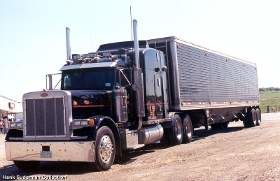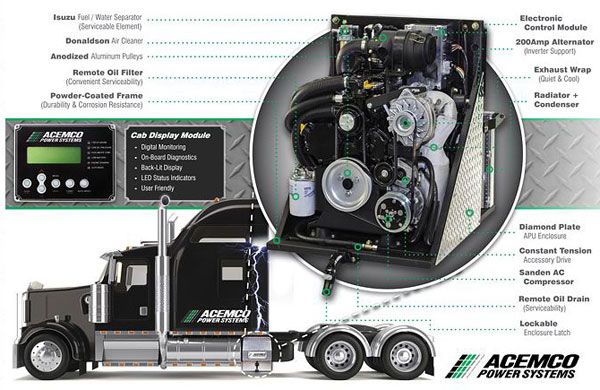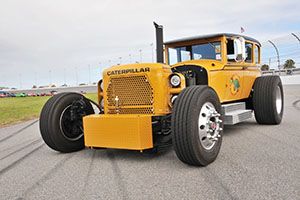Apu Exemption And Steer Axle
Topic 19425 | Page 2

Since you will lose fuel weight on the steers as you travel down the road. As long as you are within that range I wouldn't get to caught up about it. They in fact discussed it on a Friday safety meeting a little while back.
I wish I'd seen that meeting. Truth is, I rolled across many scales being at or slightly over 12k also without a problem. My 5th wheel is slid all the way back, so I have no choice. But that's a whole 'nuther story. Prime has to remount my 5th wheel further back.

Vehicle weight exemptions for APUs Remember the federal law from a few years ago that was intended to give truckers a 400-pound weight exemption for auxiliary power units? The industry hailed it as good news until we found out the law was not a "mandate." A federal law that carries no clout with the states is not much of a law if your business is hauling interstate.
Land Line published a copy of the federal language for truckers to carry in their trucks. Still, many truckers told us the states regarded it with little more than a "so what?"
The exemption, which was signed into law by President George W. Bush in August 2005 as part of the Energy Policy Act of 2005, increases a vehicle's maximum gross vehicle weight limit and axle weight limit by 400 pounds. This allows for the adding of qualified idle-reduction technology, such as an APU.
While the rule was approved, a memo out of the Federal Highway Administrations Size and Weight Division in November 2005 threw water on the good news by adding that the exemption wouldn't be treated as a federal mandate. Here's an excerpt from the FHWA memo: "We determined that (the exemption) does not pre-empt state regulations or compel the states to grant the increased weight tolerance."
Despite the lack of a mandate, more and more states are adopting the weight exemption. The following is a list of all states and their respective status on adopting the 400-pound weight exemption for APUs.
Now with the implementation of the new highway bill, MAP-21, the weight tolerance has been expanded by the feds to 550 pounds, prompting a new round of state legislation. The chart below notes the various states with exemptions, tolerances and pending legislation (designated with a footnote related to the tolerance sought).
It should be noted that states designated with asterisk do not have a state law that allows for the 400-pound weight exception. However, there are enforcement policies in place that would allow for the extra weight.
The list is compiled from information from the U.S. Department of Energy and Land Line reports on state legislation.
States
States with no exemption - California Hawaii Kentucky North Carolina Rhode Island and District of Columbia 550 pound exemptions Arkansas Colorado Connecticut Florida Maryland Minnesota Missouri New Hampshire South Carolina Tennessee Virginia and West Virginia
Interstate:
Commercial trade, business, movement of goods or money, or transportation from one state to another, regulated by the Federal Department Of Transportation (DOT).
Dm:
Dispatcher, Fleet Manager, Driver Manager
The primary person a driver communicates with at his/her company. A dispatcher can play many roles, depending on the company's structure. Dispatchers may assign freight, file requests for home time, relay messages between the driver and management, inform customer service of any delays, change appointment times, and report information to the load planners.OWI:
Operating While Intoxicated
APU:
Auxiliary Power Unit
On tractor trailers, and APU is a small diesel engine that powers a heat and air conditioning unit while charging the truck's main batteries at the same time. This allows the driver to remain comfortable in the cab and have access to electric power without running the main truck engine.
Having an APU helps save money in fuel costs and saves wear and tear on the main engine, though they tend to be expensive to install and maintain. Therefore only a very small percentage of the trucks on the road today come equipped with an APU.

APUs:
Auxiliary Power Unit
On tractor trailers, and APU is a small diesel engine that powers a heat and air conditioning unit while charging the truck's main batteries at the same time. This allows the driver to remain comfortable in the cab and have access to electric power without running the main truck engine.
Having an APU helps save money in fuel costs and saves wear and tear on the main engine, though they tend to be expensive to install and maintain. Therefore only a very small percentage of the trucks on the road today come equipped with an APU.

I've seen this, but it still doesn't address the topic of exceeding an individual component's GWR rating.
For example, a drive axle is rated at 20k. Both drives equals 40k. The exemption would allow 34400, far below the manufacturers rating for the individual component.
This wouldn't be the case with the steer axle. The exemption would exceed the manufacturer's rating for that component. Nothing I can find addresses that.
The point is moot, I guess. That nagging question boggles my noggin haha.
Go by the tire rating and honestly don't worry about it.

I've seen this, but it still doesn't address the topic of exceeding an individual component's GWR rating.
Brian did address it, see below. But I'm with you, the GAWR is a mechanical/physical limit, not a legislative limit, where does Congress get off thinking it can repeal the laws of physics by legislative fiat? Maybe they should pass a daylight savings time law that really works, all they have to do is require the sun to set later in the day.
The exemption, which was signed into law by President George W. Bush in August 2005 as part of the Energy Policy Act of 2005, increases a vehicle's maximum gross vehicle weight limit and axle weight limit by 400 pounds. This allows for the adding of qualified idle-reduction technology, such as an APU.
APU:
Auxiliary Power Unit
On tractor trailers, and APU is a small diesel engine that powers a heat and air conditioning unit while charging the truck's main batteries at the same time. This allows the driver to remain comfortable in the cab and have access to electric power without running the main truck engine.
Having an APU helps save money in fuel costs and saves wear and tear on the main engine, though they tend to be expensive to install and maintain. Therefore only a very small percentage of the trucks on the road today come equipped with an APU.


Maximum allowable weights are ALWAYS the lesser of: 1) The manufacturer's maximum for the axle as noted on the door-jamb tag, 2) The manufacturer's maximum for the tires as noted on the sidewall at maximum cold inflation, or 3) The maximum allowed by legislation (including any exemption) by either total weight or weight per inch of tire width.
The APU exemption (where accepted) allows you to increase your gross, with a corresponding increase on any/all axle(s), providing you do not exceed any component limits. Therefore, anyone telling you to exceed a weight for a tagged component is wrong. However, all states allow up to 20,000 on steers providing the axles and tires are appropriately rated.
APU:
Auxiliary Power Unit
On tractor trailers, and APU is a small diesel engine that powers a heat and air conditioning unit while charging the truck's main batteries at the same time. This allows the driver to remain comfortable in the cab and have access to electric power without running the main truck engine.
Having an APU helps save money in fuel costs and saves wear and tear on the main engine, though they tend to be expensive to install and maintain. Therefore only a very small percentage of the trucks on the road today come equipped with an APU.

Turtle, I've gone round and round with this as well. My last truck was a 14' lightweight. My steers were at 12500 and I had to roll. I asked the shop manager to get rid of the plate on my 5th wheel so I could slide it back, and they refused. "The whole fleet runs with that plate." Explained my problem of being heavy, and was told "you have 500 lbs to play with because of the APU." Then of course came the "how much fuel did you have?" Question.
My new truck is a 17' and I've yet to get over 12000 even when full of fuel and a fully loaded trailer.
Even after running @13000, I never got pulled in.
I know this is of little help, but think about this. If the DOT really wants to mess with you, they will find something. But it's a lot easier for them to hammer some fly by night grossly overweight / messed up truck than to search for stuff on a well maintained truck. That's why they always tell you to keep a clean dash. That's just a huge red flag. "If your dash / truck looks messy, the rest of your truck is probably a mess as well. "
DOT:
Department Of Transportation
A department of the federal executive branch responsible for the national highways and for railroad and airline safety. It also manages Amtrak, the national railroad system, and the Coast Guard.
State and Federal DOT Officers are responsible for commercial vehicle enforcement. "The truck police" you could call them.
APU:
Auxiliary Power Unit
On tractor trailers, and APU is a small diesel engine that powers a heat and air conditioning unit while charging the truck's main batteries at the same time. This allows the driver to remain comfortable in the cab and have access to electric power without running the main truck engine.
Having an APU helps save money in fuel costs and saves wear and tear on the main engine, though they tend to be expensive to install and maintain. Therefore only a very small percentage of the trucks on the road today come equipped with an APU.

I used to worry about this, too. Now, as long as I'm OK on gross, drives, and tandems , and my steers are under 12,500, I don't worry about it.
I quit worrying after I talked to a nice 20-year driver (not many of those!) who said he'd been running 12,250-12,500 for most of those years because he likes a little extra there for steering. He had never gotten a ticket for being overweight on his steers. He said he'd gotten tickets for being over gross and over on his drives or tandems a few times over the years, but never the steers. He wasn't the outlaw type, just a practical guy who said it didn't seem to worry the DOT too much as long as the steers were below 12,500.
FWIW, obviously.
Tandems:
Tandem Axles
A set of axles spaced close together, legally defined as more than 40 and less than 96 inches apart by the USDOT. Drivers tend to refer to the tandem axles on their trailer as just "tandems". You might hear a driver say, "I'm 400 pounds overweight on my tandems", referring to his trailer tandems, not his tractor tandems. Tractor tandems are generally just referred to as "drives" which is short for "drive axles".
Tandem:
Tandem Axles
A set of axles spaced close together, legally defined as more than 40 and less than 96 inches apart by the USDOT. Drivers tend to refer to the tandem axles on their trailer as just "tandems". You might hear a driver say, "I'm 400 pounds overweight on my tandems", referring to his trailer tandems, not his tractor tandems. Tractor tandems are generally just referred to as "drives" which is short for "drive axles".
DOT:
Department Of Transportation
A department of the federal executive branch responsible for the national highways and for railroad and airline safety. It also manages Amtrak, the national railroad system, and the Coast Guard.
State and Federal DOT Officers are responsible for commercial vehicle enforcement. "The truck police" you could call them.
HOS:
Hours Of Service
HOS refers to the logbook hours of service regulations.New Reply:
New! Check out our help videos for a better understanding of our forum features

















Preview:
This topic has the following tags:
Prime Inc Advice For New Truck Drivers DOT Truck Equipment







 TT On Facebook
TT On Facebook
Wouldn't we all. Half the things aren't in writing and are based off of a "he said, she said" system.